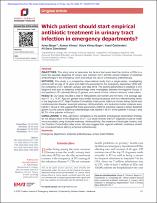| dc.contributor.author | Başer, Aykut | |
| dc.contributor.author | Yılmaz, Atakan | |
| dc.contributor.author | Başer, Hülya Yılmaz | |
| dc.contributor.author | Özlülerden, Yusuf | |
| dc.contributor.author | Zümrütbaş, Ali Ersin | |
| dc.date.accessioned | 2021-11-01T15:05:01Z | |
| dc.date.available | 2021-11-01T15:05:01Z | |
| dc.date.issued | 2020 | |
| dc.identifier.citation | Başer, A., Yilmaz, A., Başer, H. Y., Özlülerden, Y., & Zümrütbaş, A. E. (2020). Which patient should start empirical antibiotic treatment in urinary tract infection in emergency departments?. Turkish Journal of Emergency Medicine, 20(3), 111. | en_US |
| dc.identifier.issn | 2452-2473 | |
| dc.identifier.uri | https://doi.org/10.4103/2452-2473.290064 | |
| dc.identifier.uri | https://hdl.handle.net/11491/7051 | |
| dc.description.abstract | OBJECTIVES: This study aims to determine the factors that would lead the doctors in EDs to a more the accurate diagnosis of urinary tract infection (UTI) and the correct initiation of empirical antibiotherapy in the emergency room and reduce the use of unnecessary antibiotherapy. METHODS: This study is a prospective observational study from a single-center, investigating patients with an age of 18 years and older who presented to the emergency department (ED) with the symptoms of UTI between January and May 2018. The guiding parameters to establish a UTI diagnosis and start an empirical antibiotherapy were investigated between the negative (Group 1) and positive (>103 colonies) (Group 2) groups, as a result of urine culture in terms of urine culture. RESULTS: Our study included a total of 108 patients (59 women and 49 men). The average age was 47.11 +/- 14.97. Age and gender were similar among the groups and not a discriminating factor in the diagnosis of UTI. High Charlson Comorbidity Index score, history of chronic kidney failure and cerebrovascular disease, leukocyte esterase, nitrite positivity, and leukocyte cluster presence were higher in Group 2. We suggest that these parameters might be predictive values to detect bacterial growth in urine culture. Empirical antibiotherapy was started in 48.4% of the patients in Group 1 and 95.7% of the patients in Group 2. CONCLUSIONS: In EDs, admission complaints of the patients and physical examination findings do not always result in the diagnosis of UTI. Our study showed that UTI diagnosis could be made more accurately using leukocyte esterase, nitrite positivity, the presence of leukocyte clusters, and the Charlson Comorbidity Index score. We also suggest that regional antibiotic resistance should be considered before starting empirical antibiotherapy. | en_US |
| dc.language.iso | eng | en_US |
| dc.publisher | Wolters Kluwer Medknow Publications | en_US |
| dc.relation.ispartof | Turkish Journal Of Emergency Medicine | en_US |
| dc.rights | info:eu-repo/semantics/openAccess | en_US |
| dc.subject | Emergency department | en_US |
| dc.subject | Empirical antibiotherapy | en_US |
| dc.subject | Urinary tract infection | en_US |
| dc.title | Which patient should start empirical antibiotic treatment in urinary tract infection in emergency departments? | en_US |
| dc.type | article | en_US |
| dc.department | Hitit Üniversitesi, Tıp Fakültesi, Cerrahi Tıp Bilimleri Bölümü | en_US |
| dc.identifier.volume | 20 | en_US |
| dc.identifier.issue | 3 | en_US |
| dc.identifier.startpage | 111 | en_US |
| dc.identifier.endpage | 117 | en_US |
| dc.relation.publicationcategory | Makale - Uluslararası Hakemli Dergi - Kurum Öğretim Elemanı | en_US |
| dc.department-temp | [Baser, Aykut] Hitit Univ, Dept Urol, Sch Med, Corum, Turkey; [Baser, Hulya Yilmaz] Hitit Univ, Erol Olcak Educ & Res Hosp, Dept Emergency Med, Corum, Turkey; [Yilmaz, Atakan; Ozlulerden, Yusuf; Zumrutbas, Ali Ersin] Pamukkale Univ, Sch Med, Dept Urol, Denizli, Turkey | en_US |
| dc.contributor.institutionauthor | Başer, Aykut | |
| dc.identifier.doi | 10.4103/2452-2473.290064 | |
| dc.description.wospublicationid | WOS:000556675800003 | en_US |
| dc.description.scopuspublicationid | 2-s2.0-85090655662 | en_US |
| dc.description.pubmedpublicationid | PubMed: 32832730 | en_US |


















